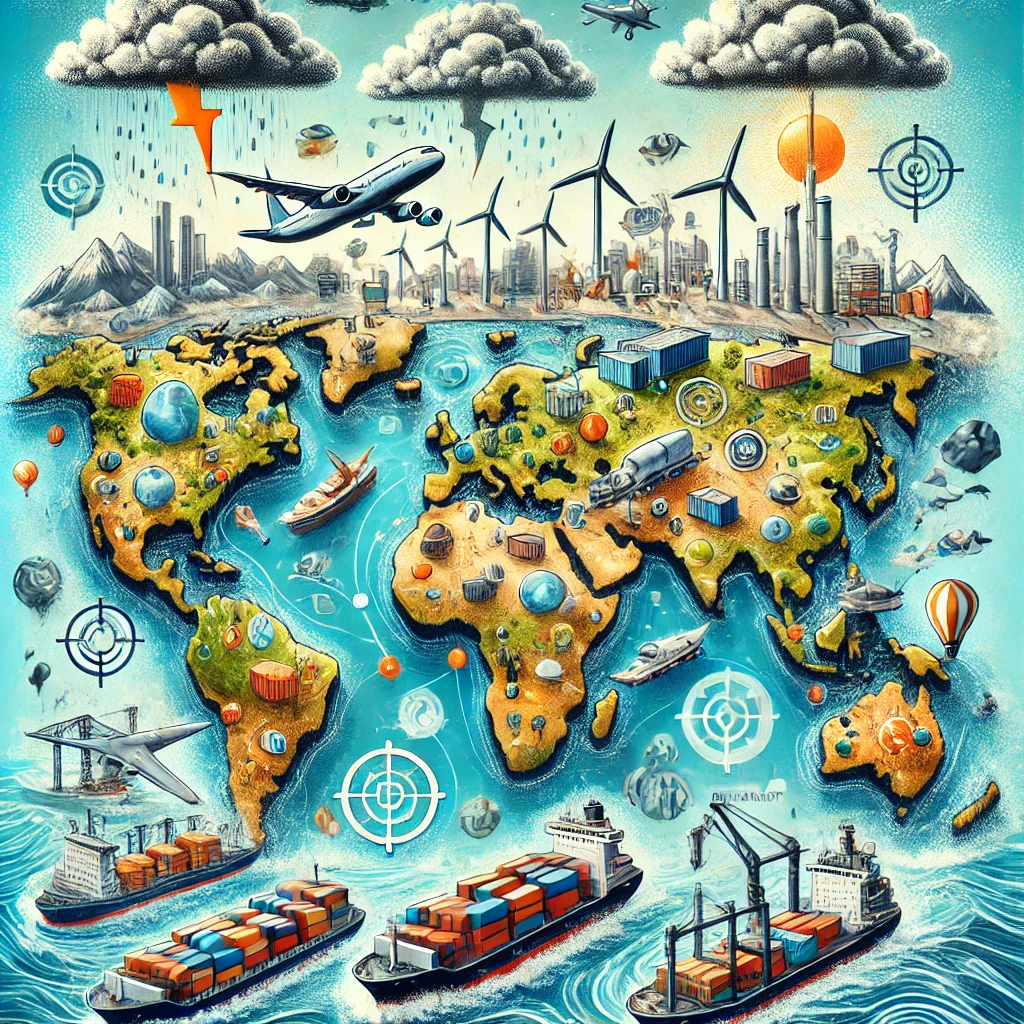Introduction to Climate Change and Global Trade
Climate change refers to long-term alterations in temperature, precipitation, wind patterns, and other elements of the Earth’s climate system.
The primary drivers of climate change are greenhouse gas emissions arising from human activity, particularly the burning of fossil fuels, deforestation, and industrial processes.
The implications of these changes are vast and multifaceted, affecting not only environmental conditions but also socio-economic structures globally.
One significant area of concern is the impact of climate change on global trade.
As shifting climate patterns lead to unpredictable weather conditions, they can profoundly influence the production and distribution of goods across nations.
For instance, extreme weather such as floods and droughts can disrupt supply chains, affecting both the availability and pricing of products.
These disruptions pose a challenge for import and export activities, as stakeholders must navigate the complexities introduced by an unstable climate.
The consequences of climate change extend beyond immediate disruptions; they also necessitate a reevaluation of trade policies and practices.
Countries heavily reliant on agriculture may need to adapt their export strategies accordingly, adjusting for changing crop yields that result from fluctuating climate conditions.
Moreover, some regions may experience a shift in their comparative advantages, requiring nations to consider new trading partners or product lines that align with their changing resource availability.
As climate change continues to reshape the global landscape, understanding its implications for trade becomes increasingly urgent.
This awareness is essential for policymakers and businesses alike, as they must devise effective strategies to adapt to these changes and safeguard their interests in an uncertain future.
By examining the intersections between climate change and trade, stakeholders can better prepare for the repercussions that will undoubtedly influence import and export practices worldwide.
The Changing Landscape of Demand for Import/Export Products
The impact of climate change on trade has become increasingly evident, influencing consumer preferences and market dynamics for various import and export products.
As the global community becomes more aware of environmental issues, there is a noticeable shift towards renewable resources, organic products, and eco-friendly goods.
This trend aligns with a broader demand for sustainability, indicating that climate change is not only an environmental challenge but also a pivotal factor in shaping consumer behavior.
One of the most significant changes in demand stems from a growing consumer inclination towards products that are sourced sustainably.
Eco-friendly goods are gaining traction as consumers seek to minimize their carbon footprints.
Items such as organic foods, biodegradable packaging, and sustainably sourced materials are increasingly favored over traditional products that may contribute to environmental degradation.
Consequently, this shift has prompted suppliers to adapt their offerings to meet the rising demand for eco-conscious alternatives.
In the realm of renewable resources, there has been a marked increase in the import and export of products that support sustainable energy solutions, such as solar panels, wind turbines, and electric vehicles.
Countries are increasingly investing in these technologies, not only to combat climate change but also to position themselves competitively in the global market.
As a result, trade patterns are shifting, with countries that prioritize sustainable development becoming key players in international trade networks.
As consumer preferences evolve in response to climate change, businesses must pivot accordingly.
The market for traditional import and export products is being reshaped as firms shift their focus toward sustainability-driven offerings.
This changing landscape necessitates that companies actively engage with consumers to understand their values and expectations, ultimately driving innovation and redefining success in the context of climate-conscious practices.
Effects of Climate Change on Agricultural Products
Climate change substantially affects agricultural production through changing weather patterns, fluctuating temperatures, and increased occurrences of extreme weather events.
These alterations result in significant challenges for farmers, impacting their ability to cultivate crops effectively.
For instance, regions that traditionally supported certain crops may find their viability diminished due to unexpected climate shifts, leading to reduced crop yields.
Variations in rainfall patterns and longer drought periods, exacerbated by climate change, can severely hinder agricultural productivity and food security.
The consequences of these agricultural disruptions extend beyond local environments, influencing global trade dynamics.
As certain regions may no longer produce staple commodities at previous levels, countries reliant on imports may face food shortages.
This situation compels importers to seek alternative suppliers, leading to shifts in global trade patterns.
Countries affected by diminishing agricultural output may struggle to meet the demands of their populations, causing an increase in import burdens and possible competition for specific food products on the world market.
Moreover, the economic impacts on agricultural sectors in various regions further complicate the trade landscape.
Farmers in affected areas may experience income losses, challenging their ability to invest in sustainable practices or adapt their operations to new climatic realities.
Consequently, this situation can lead to an overall decline in agricultural productivity, which has a cascading effect on food-related exports and imports.
As countries grapple with these challenges brought on by climate change and trade shifts, the need for resilient agricultural practices becomes increasingly urgent.
These practices can help mitigate negative outcomes and enhance food security, ensuring stability in both local and international markets.
Ultimately, the interplay between climate change and trade dictates the future trajectory of agricultural commodities, necessitating adaptive strategies and global cooperation.
Natural Disasters and Supply Chain Disruptions
The interplay between climate change and trade has become increasingly evident, particularly in how natural disasters disrupt supply chains across the globe.
As the frequency and severity of these disasters intensify, economies dependent on imports and exports are facing significant challenges.
Natural disasters, such as hurricanes, floods, and wildfires, not only damage infrastructure but also create ripple effects that impact the availability and cost of goods.
For instance, the 2011 earthquake and tsunami in Japan severely affected global supply chains, causing delays in the production of various sectors, especially automobile and electronics industries.
This incident highlights how localized disasters can reverberate throughout international trade networks.
In addition, the changing climate can alter the patterns of agricultural production, leading to shortages or surpluses of certain crops.
For example, hurricanes can devastate agricultural regions, resulting in reduced exports of key commodities such as rice and soybeans.
Conversely, favorable climate conditions may lead to increased production in some areas, yet the volatility introduced by climate change complicates forecasts and impacts trading strategies.
Thus, businesses must adapt by diversifying their supply chains and investing in more resilient infrastructure. This adaptation is vital for mitigating the risks associated with climate-induced disruptions.
The economic implications of these disruptions can be profound, affecting everything from local employment to international market prices.
Countries heavily reliant on the export of natural resources are particularly vulnerable, as they may experience fluctuations in demand and pricing due to unpredictable climate-related events.
To navigate these challenges, policymakers and businesses must consider the interdependencies between climate change and trade, emphasizing the need for disaster preparedness and adaptive strategies that can sustain international trade even amid increasing environmental uncertainties.
Emergence of New Trade Routes and Markets
The phenomenon of climate change is inducing significant alterations in global geographies, notably influencing import and export dynamics through the emergence of new trade routes.
Particularly in the Arctic region, the melting ice is exposing previously inaccessible waterways, thus transforming the landscape of international trade.
As traditional maritime paths become more navigable, businesses are increasingly eyeing these routes as potential corridors for expedited shipping, reduced travel times, and lower transportation costs.
This evolution not only fosters the development of new markets but also reconfigures existing trade relationships.
The geopolitical implications of these emerging routes are profound. Nations bordering the Arctic, such as Canada, Russia, and Norway, are adapting their policies and infrastructures to capitalize on the advantages posed by climate change.
These developments encourage an increase in economic activities and trade opportunities, but they also lead to territorial disputes and heightened competition over resources, thereby having a ripple effect on global trade agreements.
For instance, countries may engage in negotiations to establish claims over newly accessible regions, which may alter historical alliances and import-export dynamics.
Furthermore, businesses must proactively adapt to these shifts in trade routes and market landscapes. Strategic planning for potential disruptions caused by climate change is essential.
Companies involved in global supply chains will need to evaluate their logistics and assess risks associated with new Arctic routes, keeping in mind environmental factors that could impact maritime accessibility.
The integration of climate forecasts into trade strategies is becoming increasingly critical for ensuring sustainable operations and maintaining competitiveness in an ever-evolving global market.
Ultimately, climate change and trade nexus will redefine trade practices, compelling firms to innovate and respond effectively to new challenges and opportunities.
Regulatory Changes and Trade Policies
As global awareness of climate change intensifies, nations are increasingly revising their trade policies and regulations to mitigate its effects.
These changes are part of a larger strategy to address climate change and trade by promoting sustainability while ensuring the economic competitiveness of nations.
International agreements, such as the Paris Agreement, urge countries to implement measures that reduce greenhouse gas emissions. This has led to a significant shift in how goods are traded across borders.
One of the most notable changes involves the introduction of tariffs on carbon-intensive goods.
The rationale behind these tariffs is to discourage the import of products that contribute significantly to climate change, thus encouraging manufacturers to adopt greener practices.
Countries are beginning to establish carbon pricing mechanisms that will impose costs on companies whose operations result in high emissions.
This can directly influence the dynamics of international trade, as products deemed environmentally harmful may face higher costs, potentially making them less competitive in the global market.
Additionally, the regulatory landscape is being reshaped through the establishment of standards for low-emission products.
For instance, many nations are enacting laws that require importers to prove that their products meet specific energy efficiency and sustainability criteria.
Such regulations compel exporting countries to adapt their manufacturing processes to align with the demands of importing nations, fostering a ripple effect throughout the global supply chain.
Furthermore, trade agreements increasingly highlight environmental standards, linking trade benefits to compliance with climate-friendly regulations.
This intersection of climate change and trade not only promotes responsible consumption but also encourages innovation in environmentally sustainable technologies.
As these regulatory changes continue to evolve, they play a critical role in shaping the future landscape of global trade and its interaction with climate change mitigation efforts.
Innovations in Sustainability and Technology
As climate change continues to pose significant challenges to global trade, the advancement of innovative technologies and sustainable practices is crucial in mitigating its effects.
The integration of sustainability into manufacturing processes and logistics is transforming the landscape of import and export products.
Companies are increasingly adopting eco-friendly techniques and technological innovations that not only enhance operational efficiency but also reduce their environmental footprint.
One prominent innovation is the development of green supply chain management systems.
These systems utilize data analytics and real-time tracking to optimize logistics and reduce carbon emissions associated with transportation.
By employing artificial intelligence, companies can forecast demand more accurately, allowing for reduced stockpiling and waste.
This technology-driven approach leads to more efficient use of resources, directly benefiting climate change and trade by minimizing the ecological impact of moving goods globally.
Moreover, sustainable manufacturing practices are being embraced more widely in response to climate change.
For instance, circular economy principles advocate for the recycling and reusing of materials in production processes.
This shift not only conserves natural resources but also helps establish a more sustainable supply chain that meets changing consumer demands for environmentally friendly products.
Many businesses are also exploring renewable energy sources for their operations, thereby lowering their carbon footprint and contributing to global climate resilience.
Additionally, innovations such as biodegradable packaging and energy-efficient machinery are gaining traction in the industry.
These technologies reflect a growing commitment among businesses to align with environmental sustainability goals.
As trade patterns evolve, the adoption of these sustainable practices will likely become a decisive factor in competitiveness and consumer preference, ultimately shaping the future of global trade in light of climate change.
Consumer Awareness and Ethical Trade
In recent years, there has been a significant shift in consumer behavior driven by increased awareness regarding climate change and its implications on trade practices.
Modern consumers are becoming more conscientious about the environmental impact of their purchases, actively seeking products that align with ethical considerations.
This growing awareness reflects a broader understanding of how trade practices contribute to climate change, prompting a demand for sustainability throughout supply chains.
The influence of climate change on trade has encouraged consumers to prioritize products that not only fulfill their requirements but also adhere to ethical standards.
Shoppers are increasingly inclined to support businesses that demonstrate a commitment to environmental stewardship, transparent sourcing, and fair labor practices.
This trend highlights a shift from traditional purchasing habits to a more values-driven approach where products are scrutinized based on their ecological footprint and the ethical implications of their production.
As a result, brands are responding to this shift by adopting sustainable practices in their import and export activities.
Many companies are now emphasizing transparency in their supply chains, ensuring that their products are sourced ethically and produced with minimal environmental impact.
Sustainable certifications and eco-labels have gained prominence as consumers seek reassurance that their choices contribute positively to combating climate change.
This heightened consumer awareness is reshaping the dynamics of global trade. Importers and exporters are compelled to adapt their strategies to align with the preferences of a more environmentally conscious market.
Businesses that prioritize ethical trade practices not only enhance their reputation but also tap into a growing segment of consumers who value sustainability.
The integration of climate change considerations into trading practices signifies a crucial evolution in consumer behavior, ultimately fostering a marketplace that values both social responsibility and environmental sustainability.
Conclusion and Future Outlook
The interplay between climate change and trade is increasingly influencing global import and export dynamics.
As nations grapple with the effects of climate change, various sectors are witnessing altered trade patterns, particularly in agriculture, energy, and manufactured goods.
Climate-related disruptions such as droughts, floods, and severe weather conditions pose significant threats to production rates and supply chains, ultimately affecting the market availability of goods.
Consequently, countries are urged to reconsider their trade policies and strategies to accommodate these emerging challenges.

Adaptation measures are becoming imperative as climate change continues to impact trade routes and accessibility to resources.
For instance, nations that rely heavily on agricultural exports must invest in resilient farming practices and technologies to withstand environmental shifts.
Additionally, diversifying trade partners can mitigate risks associated with localized climate events.
Sustainable sourcing practices that consider the environmental impact of goods will also shape future trade policies, as consumers increasingly prioritize eco-friendly products.
The outlook for global trade amid climate change is one necessitating flexibility and innovation.
The growing emphasis on sustainability signifies a shift towards greener trade practices, compelling businesses to assess their carbon footprints and sourcing methods.
As climate commitments intensify worldwide, organizations that proactively adapt to these changes are likely to thrive in the evolving landscape.
Thus, comprehending the relationship between climate change and trade is crucial for policymakers and stakeholders aiming to ensure a resilient trading environment in the face of ongoing environmental challenges.






No comment yet, add your voice below!